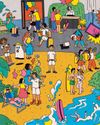
A few months before nonfungible tokens exploded into the public consciousness, the field was already pretty big, with some 75,000 buyers in 2020, according to a report by market researcher NonFungible and L’Atelier BNP Paribas. But it was also still sleepy.
The term “NFT” is often used as a shorthand for a certain kind of blockchain-linked artwork, but it really refers to the digital certificate of authenticity to which these artworks are attached. The first ones were conceived as early as 2012, as digital coins that represented coupons, subscriptions, or company shares. An NFT can be created for anything, whether a century-old painting or a tweet, attesting to the blockchain’s guarantee that it’s the original, no matter how many free JPEG replicas you can dig up on Google Images. Half of the NFT sales made in 2020, according to the NonFungible report, were related to video games; 8% were connected to metaverses, virtual “worlds” where participants can buy land and virtual goods. Artworks made up only 5% of NFTs’ total market distribution, and most sold for under $100.
In March, though, NFT art began seizing headlines. Christie’s auctioned a collage of images by the creator known as Beeple (real name Mike Winkelmann, a graphic designer in Charleston, S.C.) to a Singapore-based crypto investor who paid $69.3 million worth of Ether, more than 10 times the record value of any other known NFT sale. Images by other artists, such as Pak, Mad Dog Jones, and Micah Johnson, started routinely selling for tens of thousands of dollars on digital marketplaces such as OpenSea and Nifty Gateway. As curiosity spiked, everything from (real) houses to Taco Bell-licensed pictures of Mexican food to LeBron James dunk highlights began to come with an NFT. Charmin released images they of course called NFTPs.
Denne historien er fra April 19, 2021-utgaven av Bloomberg Businessweek.
Start din 7-dagers gratis prøveperiode på Magzter GOLD for å få tilgang til tusenvis av utvalgte premiumhistorier og 9000+ magasiner og aviser.
Allerede abonnent ? Logg på
Denne historien er fra April 19, 2021-utgaven av Bloomberg Businessweek.
Start din 7-dagers gratis prøveperiode på Magzter GOLD for å få tilgang til tusenvis av utvalgte premiumhistorier og 9000+ magasiner og aviser.
Allerede abonnent? Logg på

Instagram's Founders Say It's Time for a New Social App
The rise of AI and the fall of Twitter could create opportunities for upstarts

Running in Circles
A subscription running shoe program aims to fight footwear waste

What I Learned Working at a Hawaiien Mega-Resort
Nine wild secrets from the staff at Turtle Bay, who have to manage everyone from haughty honeymooners to go-go-dancing golfers.

How Noma Will Blossom In Kyoto
The best restaurant in the world just began its second pop-up in Japan. Here's what's cooking

The Last-Mover Problem
A startup called Sennder is trying to bring an extremely tech-resistant industry into the age of apps

Tick Tock, TikTok
The US thinks the Chinese-owned social media app is a major national security risk. TikTok is running out of ways to avoid a ban

Cleaner Clothing Dye, Made From Bacteria
A UK company produces colors with less water than conventional methods and no toxic chemicals

Pumping Heat in Hamburg
The German port city plans to store hot water underground and bring it up to heat homes in the winter

Sustainability: Calamari's Climate Edge
Squid's ability to flourish in warmer waters makes it fitting for a diet for the changing environment

New Money, New Problems
In Naples, an influx of wealthy is displacing out-of-towners lower-income workers